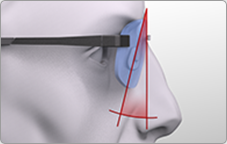
ALLENTOWN OPTICAL’S DIGITAL DESIGNS
- DAILY C
- DAILY BASIC
- FOCUS SINGLE VISION
- OFFICE: PERSONAL, ASSISTANT, SUPERVISOR
- PARAMETER
- PETITE
- PROXIMITY
Conventional Progressives
Traditionally, progressive lenses have been produced using a molded blank that incorporates the progressive surface on the front side. These progressive blanks are produced in large quantities, and are available in multiple materials, each with a range of base curves, each with several add values. The wearer prescription is generated using traditional equipment to cut a simple curve, a sphere or a torus, on the back side of the lens.
The progressive design itself is fixed, molded on the front surface, and it doesn’t change for different prescriptions. All wearers of a particular progressive will end up getting identical lens designs. However, ideally a progressive lens should be different for each wearer, and the design should change not only with the prescription, but also with other factors such as the lens material, the selected frame, and the visual needs of the wearer. With conventional progressives, personalization for each wearer is not possible, and that is a significant limitation.
Personalization
Personalization can make a big difference in ophthalmic lenses, both single vision and progressive. When a lens is optimized for a single wearer, the best possible optics are achieved. Even two wearers with the same prescription and lens material will receive different lenses comprehensively tailored to their individual biometrics and frame selection. Each wearer will experience the best quality of vision and superior comfort.
Digital Progressive Lenses
What are the advantages
of digital surfacing?
Digital surfacing technology has been a real revolution in the optical industry. This lens production technology allows the optical lab to generate and polish a complex surface on the back side that is specifically designed for each lens. With this new production method, the lens is processed from a molded blank that has a spherical front surface. The progressive design, combined with the prescription, is processed on the back surface of the lens.
The main advantage offered by this technology is the ability to produce personalized lenses. The lens design becomes unique, according to the prescription, material, frame and even the visual preferences selected by each wearer.
What makes some
digital lenses better?
The term “digital lens” applies to any lens made with digital surfacing technology. But in order to achieve optical performance superior to that of conventional progressives, the lens has to be calculated using an advanced lens design technology. The digital surface has to be computed in a way that uses the wearer’s individual information to provide better vision, on every point of the lens, for that specific person. And this is exactly what
Digital Ray-Path® does.

Horizontal Box Size (HBOX), Vertical Box Size (VBOX) and Distance Between Lenses (DBL)
Frame dimensions are used to calculate the final diameter and thickness of the lens. Lens diameter will be selected automatically to obtain the minimum possible thickness. Frame dimensions also improve the efficiency of the optimization, because the final lens is optimized only where it is needed. Finally, pupil heights can be used to automatically select the best corridor length in progressive lenses, in cases where it is not specifically indicated by the ECP.
Pantoscopic Angle (PANTO)

This is the angle in the vertical plane between the optical axis of a spectacle lens and the visual axis of the eye in primary position.
Wrap Angle (ZTILT)

Frame curvature
Back Vertex Distance (BVD)

Distance between the cornea and the back surface of the lens.
Pantoscopic, wrap angle and back vertex distance are used by Digital Ray-Path® to factor in the real position of the lens in front of the eye.
